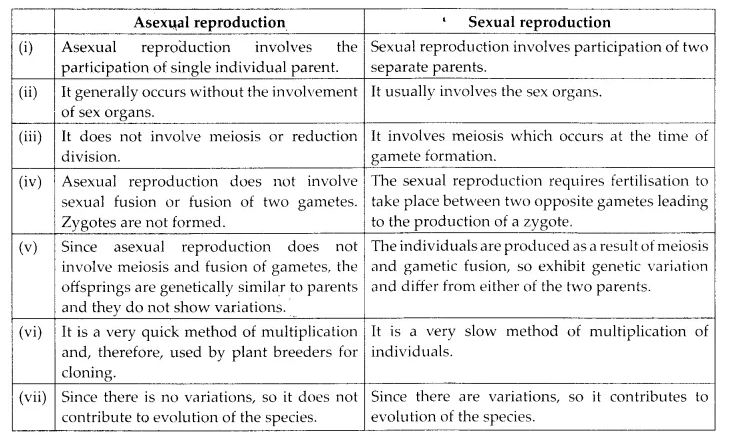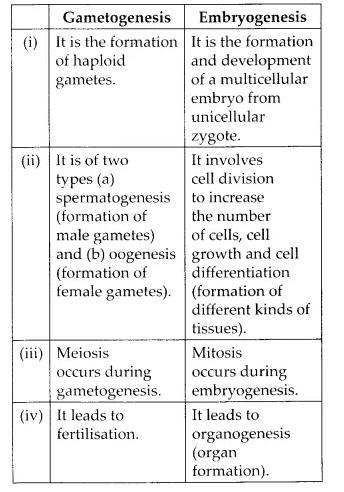NCERT Solutions for Class-12 Biology Chapter-1 Reproduction in Organisms
NCERT EXERCISE
Question 1. Why is reproduction essential for organisms?
Solution: An organism gives rise to young ones by reproduction. The offspring grow, mature, and in turn, produce new offspring. Thus, there is a cycle of birth, growth, and death. Reproduction enables the continuity of the species, generation after generation. So, therefore reproduction is essential.
Question 2. Which Is a better mode of reproduction: sexual or asexual? Why?
Solution: Sexual reproduction is a better mode of reproduction than asexual mode because the former contributes to the evolution of the species by introducing variation in a population and occurs much more rapidly. Variation in a population occurs because of the fusion of male and female gametes (sexual reproduction) carrying different sets of chromosomes.
Question 3. Why is the offspring formed by asexual reproduction referred to as clones?
Solution: In sexual reproduction, the offspring is morphologically and genetically identical to the parent and to each other. Hence, it is called a clone.
Question 4. Offspring formed due to sexual reproduction have better chances of survival. Why? Is this statement always true?
Solution: The offspring that are produced by sexual reproduction are not genetically identical to their parents. They exhibit variations because they receive chromosomes from two different parents. Since they show variation, they are highly adapted to the changing environment. Asexually produced organisms are genetically identical and all organism show similar adaptations. So, during any calamity, there is a possibility that the whole generation would destroy leading to extinction of species. However, this statement is not true always because of some inborn genetic disorder due to which organism have a risk in their survival, e.g., Haemophilia.
Solution: The progenies have similar genetic make-up and are exact copies of their parents in asexual reproduction but the progenies have different genetic make-up and different from each other and dissimilar to the parent in sexual reproduction.
Variation is absent in asexual reproduction but it is a common phenomenon of sexual reproduction. In asexual reproduction, variation may occur due to mutation whereas variation occurs due to mutation, crossing over, and recombination in sexual reproduction.
Question 6. Distinguish between asexual and sexual reproduction. Why is vegetative reproduction also considered as a type of asexual reproduction?
Solution: The differences between asexual and sexual reproduction are given in the following table:
As vegetative reproduction does not involve two parents and any meiosis and syngamy so it is considered as a type of asexual reproduction. This term is used in the case of plants.
Solution: In plants, the vegetative propagules (runner, rhizome, sucker, etc.) are capable of producing new offsprings by the process called vegetative propagation. As the formation of these vegetative propagules does not involve both the parents, the process involved is asexual.
Examples:
(i) Adventitious buds in the notches along the leaf margins of the Myriophyllum grow to form new plants.
(ii) Potato tuber having buds when grown develops into a new plant.
(i) Juvenile phase
(ii) Reproductive phase
(iii) Senescent phase
Solution:
(i) The juvenile phase is the period of growth between the birth of an individual till reaches reproductive maturity. In plant, this is also called the vegetative phase.
(ii) The reproductive phase starts after the vegetative phase (juvenile phase) and the organisms produce offspring during this phase. A few plants show unusual flowering phenomena. Some of them such as bamboo species, flower only once in their lifetime, usually after 30-100 years. They produce large number of fruits and die. Among animals such as birds living in nature lay eggs seasonally while birds in captivity (as in poultry farm) can be made to lay eggs throughout the year.
(iii) Senescent phase or old age begins at the end of reproductive phase. It is last phase of life span during which there is progressive deterioration in the body and loss in the capability of reproduction. Old age ultimately leads to death of the organism. In plants, it is characterized by the yellowing of leaves and leaf fall.
Solution: Higher organisms have resorted to sexual reproduction to:
(i) Get over the unfavourable condition
(ii) Restore high gene pool in a population
(iii) Restore vigour and vitality of the race and Get proper parental care
(iv) Introduce variation to enable better adaptive capacity.
Question 10. Explain why meiosis and gametogenesis are always interlinked?
Solution: Gametogenesis refers to the process of the formation of gametes. Gametes are haploid cells. If the organism is diploid it undergoes meiotic division to produce haploid gamete. So gametogenesis and meiosis are always interlinked.
(i) Ovary…..
(ii) Anther….
(iii) Egg…..
(iv) Pollen….
(v) Male gamete…..
(vi) Zygote…..
Solution:
(i) Ovary – Diploid(2n)
(ii) Anther – Diploid(2n)
(iii) Egg – Haploid(n)
(iv) Pollen – Haploid(n)
(v) Male gamete – Haploid(n)
(vi) Zygote – Diploid(2n)
Question 12. Define external fertilization. Mention its disadvantages.
Solution: In most aquatic organisms such as majority algae, fishes and amphibians, syngamy occurs in the external medium i.e., outside the body of the organism. This type of gametic fusion is called external fertilisation. A major disadvantage is that the offspring are extremely vulnerable to predators threatening their survival.
Question 13. Differentiate between a zoospore and a zygote.
Solution: Zoospores are The microscopic, flagellated (motile) special asexual reproductive structures found in certain members of the kingdom fungi and simple plants like algae whereas zygote is a diploid cell formed by die fusion of male and female gametes. The zygote is usually non flagellated.
Zoospores are the structures that give rise to new organism whereas zygote is formed after fertilization which develops into a mature organism.
Question 14. Differentiate between gametogenesis from embryogenesis.
Solution: The differences between gametogenesis and embryogenesis are given in the following table:
Solution: The post-fertilization changes that take place in a flower are as follows:
(i) The formation of zygote which later develops into an embryo and a primary endosperm cell which develops into an endosperm takes place.
(ii) While the sepals, petals and stamens are shed, the pistil remains intact.
(iii) The fertilized ovule develops into seeds.
(iv) The ovary matures into a fruit that later develops a thick protective wall, called the pericarp.
(v) Seeds after dispersal germinate under favourable conditions which later develop into a new plant.
Question 16. What is a bisexual flower?
Solution: A bisexual flower possesses both male and female reproductive structures i.e., stamens and carpels are present in the same flower
e.g.. Rose (Rosa dim), Kikar (Acacia nilotica), China rose (Hibiscus rosa sinensis) etc.
Question 17. Examine a few flowers of any cucurbit plant and try to identify the staminate and pistillate flowers. Do you know any other plant that bears unisexual flowers?
Solution: Other unisexual plants are com, papaya, cucumber etc.
Question 18. Why are offspring of oviparous animals at a greater risk as compared to offspring of viviparous animals?
Solution: Cucurbit plant bears unisexual flowers as these flowers have either the stamen or the pistil. The staminate flowers bear bright, yellow-colored petals along with stamens that represent the male reproductive structure. On the other hand, the pistillate flowers bear only the pistil that represents the female reproductive structure. Other examples of plants that bear unisexual flowers are corn, papaya, cucumber, etc.

0 comment
Post a Comment